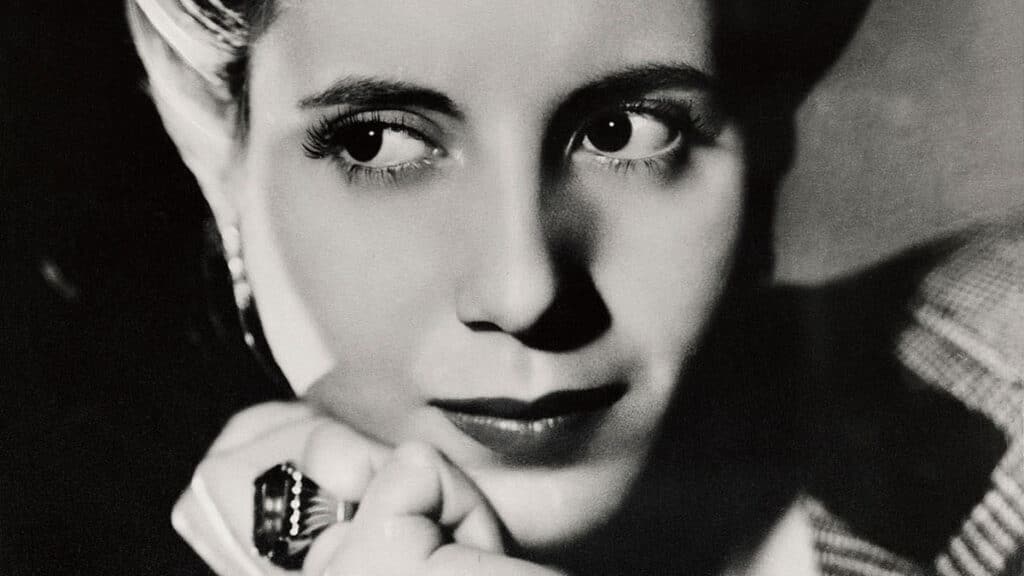“Evita” Eva Perón was an actress and radio host who became a beloved first lady of Argentina. She is famous around the world for the Rice/Webber Broadway musical and movie “Evita.”
Eva María Duarte

Eva María Duarte was born poor in the village of Los Toldos on May 7, 1919. It’s a small town near Junin about four hours drive from Buenos Aires.
Her father was French Basque. Her mother was Spanish Basque. The father abandoned the family which left them poverty-stricken and stigmatized for being an illegitimate family.
In 1934, when she was 15, Eva moved to Buenos Aires to become an actress. At the time Buenos Aires was at the peak of its power. It was called “the Paris of South America” because Argentina was then a rich country and many buildings on the main street, Avenida de Mayo, were designed in the French art nouveau style.
Eva found work in theater, in modeling and even acted in a couple of movies. Most importantly, she became a radio star. It is notable that Eva was able to prosper because the Great Depression had filled the city with poor people from the countryside.
Eva Perón
In 1944 Eva met Colonel Juan Perón at a gala benefit at Luna Park the main Buenos Aires stadium. They married in 1945.
When Juan ran for president, Eva used her radio platform to rally the people. Having grown up poor, she knew how to connect with common people. Eva also campaigned with Juan around the country. No woman had ever taken such a public role in Argentina.
Juan Perón became President of Argentina in 1946. Eva Perón became a popular figure among Argentina’s trade unions. She also led the ministries of Labor and Health and founded the Peronist Women’s Party.
Evita
At this time Eva Perón became Evita, adopting the diminutive version of her name. This was part of managing the myth of Eva as a champion of the poor masses. Eva and Juan were masters of propaganda. They also coopted Argentine tango. The tactics they used may remind you of a recent American entertainer turned political leader.
In 1947, the Spanish dictator Franco invited Juan Perón to visit Spain. Because Franco was shunned internationally (like Korea is now), Juan sent Evita instead. They turned the visit into a European tour that made her famous around the world.
In 1951, Evita considered running for vice president. She and Juan held a famous rally on Avenida 9 de Julio in front of about two million people. The crowd would demand that Evita announce her official run for president. She would ask them for more time. The crowd would chant, “Now, Evita, Now!” and they would go back and forth. The rally ended with Evita saying she would announce her decision in a few days on the radio.
Under pressure and in failing health, Evita finally decided not to run. Instead she was given the official title of “Spiritual Leader of the Nation.”
Evita had cervical cancer. She died in 1952. Her funeral procession brought out about three million people. Evita’s body was embalmed and intended to be displayed in a monument in Buenos Aires.
Juan Perón was overthrown by the military in 1955. Somehow, her body was buried in Milan. In exile in Spain, Juan had Evita exhumed and her body brought to him in 1971.
Juan Perón became Argentine president for a third time in 1973. When he died in 1974, his third wife Isabel Perón because president. She brought Evita’s body back to Argentina and buried her in the famous Recoleta cemetery. Her grave remains a popular pilgrimage site today.
In 2002, a building that once housed the Eva Perón Foundation was turned into el Museo Evita.
“Don’t Cry For Me Argentina”
In 1976, Tim Rice and Andrew Lloyd Webber wrote the musical Evita. It won a 1978 Olivier Award.
The Broadway production won a 1980 Tony Award for “Best Musical.”
The story was adapted as a movie starring Madonna in 1996. Madonna won a Golden Globe award for “Best Actress in a Musical or Comedy.”
